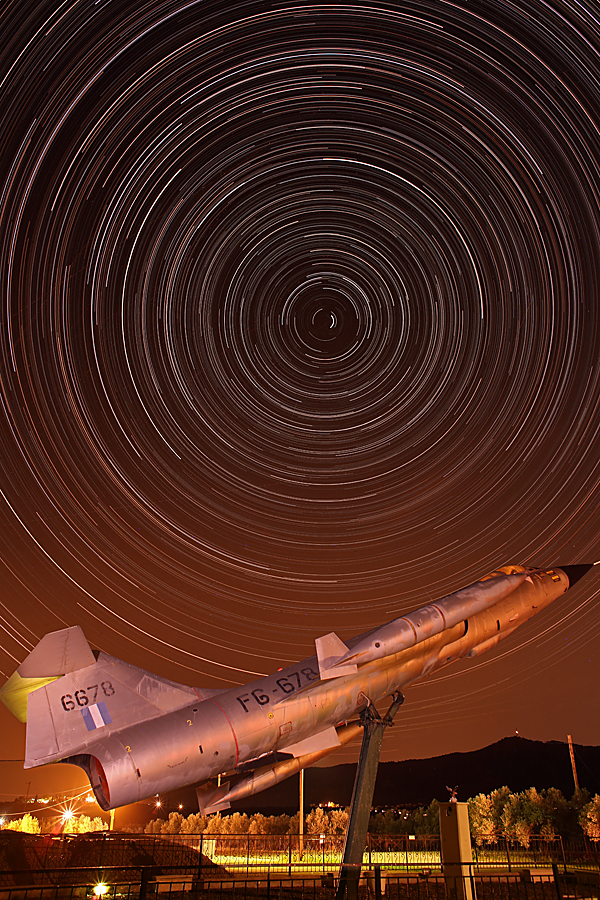
One of the most basic types of astrophotography and yet equally stunning is that involving star trails, particularly
around the celestial poles or immediately due east or west. In addition to capturing the motion of stars around the
north pole which are circumpolar and, hence, never rise or set, we also have the ability to capture seasonal
constellations and stars in such photos, thus allowing for different opportunities during different seasons. Star trail
photos also provide direct evidence that our planet rotates and does so at a rate of 15° per hour. Furthermore, by
studying the arc for a particular star, especially as far away from the pole as possible, one can indirectly estimate
the length of the (total) exposure which often ranges from seven to eight hours in duration and is totally dependent
on the end of astronomical twilight one evening and its onset
the following morning.
Many star photos are centered on Polaris, a double star system which represents our quickest means to locating the
north celestial pole, for it lies less than 1.0° from it, and is an excellent starting point for the polar alignment
of a telescope (and finding your way home if you are lost!). Due to the extended length of the typical exposures
involved, the best film for such work is Kodak Elite Chrome (ISO 100) whose reciprocity failure is nearly zero or
Fujichrome Velvia and Provia (ISO 50 and 100) emulsions with equally impressive curves! With respect to equipment, it
is rudimentary, for a camera with extended exposure capibility is required along with a firm tripod and shutter
release and locking cable. It is also preferable that the camera used have a mechanical shutter so that battery
consumption and power does not become an issue during mid-exposure. The final requirement is a location with dark
skies - the darker the better so that the trails and their colouration will be as bright and contrasty as possible -
with, preferably, an interesting foreground which can be used to enrich the final result.
Note: Lockheed's F-104 Starfighter shown below is a single-engine aircraft which saw service
with fifteen militaries across the world including Greece's Hellenic Air Force. It is a single-pilot aircraft measuring
16.7 meters in length, 4.11 meters tall and with a wingspan of 6.63 meters across. It can achieve a maximum speed of Mach 2
(2,459 km/h) with a combat and ferry range of 676 km and 2,623 km respectively. Over 2500 units were produced between 1958
and 2004 with the F-104G variant - a multi-role fighter-bomber - accounting for nearly 45% of the total. It has the ability
to carry up to four AIM-9 Sidewinder short-range air to air missiles.
The F-104 Starfighter on display below at Athikia, Corinthia, Greece was erected in 2009 and is dedicated to the pilots of
Greece's Hellenic Air Force who are from the area of Athikia and the district of Corinth in general who gave their lives while
serving and defending their country.
|
Proper Star Name: Polaris Bayer Letter: á Ursae Minoris Tycho Catalog: TYC 4628-237-1 SAO Catalog: SAO 308 Luminosity 2290 +/- 282 x Sun Distance: 431 +/- 26 light yrs RA / Dec: 02h 39m 31s / +89° 17' 39" B-V Color Index: +0.570 mag Magnitude: 1.98 |
 |
Date: Jul 26-27, 2019 22:54 - 04:52 UT+3 Location: Athikia, Corinthia, Greece Equipment: Canon EOS 6D Baader BCF2 Filter Canon EOS EF 28mm/f1.8 USM @ f9.0 Exposures: 358 min (352 x 60 sec) (RGB) 007 min (007 x 60 sec) (Dark) ISO 800 JPG Fine Image Format 5472x3648 Image Size Custom White Balance Manual Mode Continuous Servo Mode Software: Sequator V1.4 Photoshop CS5 Processing: Dark Frame Reduction Layers and Lighten Resampling Unsharp Masking JPG Compression |